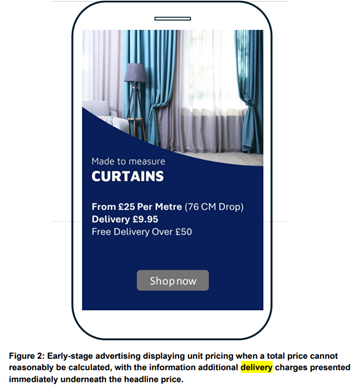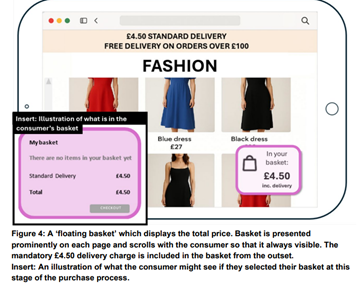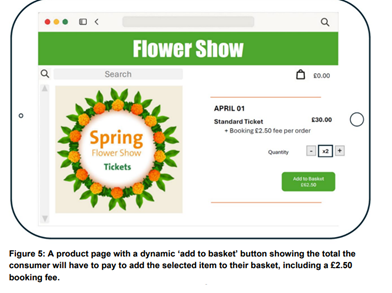- Accueil
- Actualités et public…
- Publications
- Delivery charges: wh…
- Sur cette page
24 septembre 2025
Advertising Quarterly - Q3 2025 – 1 de 6 Publications
Delivery charges: what do the draft CMA pricing guidelines mean?
- In-depth analysis
The CMA has recently consulted on draft guidance setting out how the new provisions on pricing in the Digital Markets Competition and Consumers Act 2024 (DMCC) should be interpreted. Although the guidance is still in draft form, here we set out what it will likely mean for the display of delivery charges on websites. For background to the draft guidance and pricing, see here and here.
Overriding principles
- The key requirement in the DMCC is that the “total price” of a product must be set out prominently in all invitations to purchase (ITPs). (For what constitutes an ITP, see here.) The total price includes all payments that the consumer will necessarily incur. It therefore includes all mandatory delivery charges.
- However, there is a possible exception in the DMCC. Where, due to the nature of the product, a mandatory delivery charge cannot reasonably be calculated in advance, information on how the delivery charge will be calculated must be included in all ITPs. That information must be set out with as much prominence as the total price of the product and enable the consumer to calculate the total price of the product. The equal prominence requirement generally means that the information must be set out next to or immediately underneath the total price.
- Traders should satisfy themselves that the mandatory delivery charge is genuinely not calculable in advance before relying on the exception. The CMA has said that the exception will apply narrowly. Furthermore, as soon as it becomes possible to calculate the mandatory delivery charge (eg because the consumer has entered certain information), the delivery charge should be included in the total price of the product in all ITPs from that point onwards.
- The practice of providing the component parts of a price (partitioned pricing) without giving the overall total will generally be prohibited since it is not consistent with the requirement to provide the "total price" of the product.
- Delivery charges not included in the total price but which the consumer may choose to incur must also be set out in all ITPs. Where they cannot reasonably be calculated in advance, the fact that they may be payable should be stated instead. Again, traders should satisfy themselves that a delivery charge is genuinely optional before relying on this provision.
- Mandatory and optional delivery charges must be set out in all ITPs in a way that is clear, timely, and likely to be seen by the consumer.
- Where, by exception, the means of communication used has limitations that mean that it is genuinely not practicable to present all the required pricing information on the face of the ITP, the trader should take steps to overcome these limitations in order to provide the consumer with the required pricing information by another means. The DMCC and draft guidelines should be consulted on this – we do not cover the options here.
Next, we look at what these provisions mean for the display of pricing for different delivery options on websites. Unless otherwise stated, we assume that a particular delivery cost is mandatory.
Mandatory delivery charges apply per product
Where delivery charges apply on a per-product basis, they should be included in the total price of the product in all ITPs. This is because they can be calculated in advance. Acceptable ways to do this include:
- £25 + £5 delivery - £30 total
- £30 (incl. £5 delivery)
- £30.
The following are not acceptable:
- £25 + £5 delivery – not acceptable as total price not stated
- £25 – not acceptable as mandatory £5 delivery charge not included.
It is perfectly acceptable to partition the total price (if desired) by setting out its component parts. However, the total price must always be stated clearly and prominently in all ITPs. It is not enough to present the individual price components and expect consumers to calculate the total price for themselves. Likewise, it is not acceptable to set out the total price in one ITP but not others.
Mandatory delivery charges vary according to nature of product
Where delivery charges vary because of the nature of the product (eg the product is sold by weight or length), they should fall within the exception. They do not need to be included as part of the total price of the product until known. However, details on how to calculate them must be set out with as much prominence as the total price. Once known, they must be included in all ITPs. Acceptable ways to do this include:
- Website listings before quantity selected: £25 + £2/kg delivery
- Website listings once quantity selected: the CMA guidance suggests that, once the quantity has been selected, the total price (including delivery) should be displayed on the product listing pages (and throughout the purchasing process) using a prominent running total that updates automatically. It suggests that using one of the following would comply: (a) a floating basket, (b) a dynamic 'add to basket' function or (c) a basket display after each product selection (see paragraph 5.6 of the draft guidance for more).
- Basket once quantity selected: the basket should display the total price (including delivery) based on the products selected at that point. Examples of how this information can be presented are set out in the paragraph on per product charges above. More information can also be given if desired eg £25 + £4 delivery (£2/kg) - £29 total. If delivery charges change as the consumer selects different products, those charges (and the total price) should update automatically. All ITPs onwards – such as check out pages – should also display the total price of the product, including mandatory delivery charges.
Note that, where a delivery charge is based on the weight/size of a product but the trader knows the weight/size in advance, the trader is expected to calculate the delivery charge in advance and include it in the total price of the product. Examples of where this could arise include where the trader is selling white goods (where the weight will be known in advance) or sells items in set weights/lengths.
Mandatory delivery charges apply per order
The CMA has said that it may not always be realistic or meaningful to include delivery charges in the total price of each product when these charges will only be paid once (ie irrespective of the number of items purchased). The exception would therefore apply: details of how to calculate the delivery charge must be set out in all ITPs with as much prominence as the total price. Acceptable ways to do this include:
- Website listings: £25 + £4.50 delivery per order
- Basket: the CMA guidance suggests that the set delivery charge should be incorporated into the basket, even before items are placed into the basket (as per figure 4 of the CMA's draft guidance below). The delivery charge would not usually vary as additional items are added to the basket (as delivery is fixed irrespective of the number of items purchased). It can therefore be included from the outset. Once items are added to or removed from the basket, the total price should vary (based on the price of those items), but it should always include the set delivery charge. Examples of how this information can be presented in the basket are set out in the paragraph on per product charges above. More information can also be provided eg £25 + £4.50 delivery/order - £29.50 total. All ITPs onwards – such as check out pages – should also display the total price of the product, including mandatory delivery charges.
Mandatory delivery charges vary according to products purchased
The CMA has said that, where a delivery charge varies according to the items purchased, these charges should also fall within the exception. They do not need to be included as part of the total price of the product until they are known. However, details on how to calculate them must be set out separately with as much prominence as the total price in all ITPs. Once known, they must be included in all ITPs. Acceptable ways to do this include:
- Website listings before item(s) selected: £25 + £5 delivery (for 1-2 books) or £25 + £5 delivery/item (max. £15/order)
- Website listings once item(s) selected: the CMA guidance suggests that, once an item has been selected, the total price (including delivery) should be displayed on the product listing pages (and throughout the purchasing process) using a prominent running total that updates automatically. It suggests that using one of the following would comply: (a) a floating basket, (b) a dynamic 'add to basket' function or (c) a basket display after each product selection (see paragraph 5.6 of the draft guidance for more).
- Basket once item(s) selected: once an item has been selected, the total price of the product in the basket should include the delivery charge for this item. Examples of how this can be done are set out in the paragraph on per product charges above. Again, additional explanatory information could be provided eg £25 + £5 delivery/item (max. £15/order) - £30 total. This figure should vary automatically as additional items are added to or removed from the basket. All ITPs onwards – such as check out pages – should also display the total price of the product, including mandatory delivery charges.
Mandatory delivery charges vary by location/distance
Where delivery charges vary by location, the CMA has suggested that they can also benefit from the exception. They do not need to be included as part of the total price of the product until known. However, details on how to calculate them must be set out in all ITPs with as much prominence as the total price. Once known, they must be included in all ITPs. Acceptable ways to do this include:
- Website listings before location known: £40 + £3-£12 delivery (varies by location) - enter postcode for exact total OR £40 - delivered locally in Edinburgh for free. £5 delivery charges apply outside Edinburgh. £10 delivery charges apply to the Highlands & Islands.
- Website listings once location known: the CMA guidance suggests that, once the delivery location is known, the total price (including delivery) should be displayed on the product listing pages (and throughout the purchasing process) using a prominent running total that automatically updates. It suggests that using one of the following would comply: (a) a floating basket, (b) a dynamic 'add to basket' function or (c) a basket display after each product selection (see paragraph 5.6 of the draft guidance for more).
- Basket: the CMA guidance implies that the range of delivery charges (eg £3-£12 (varies by location)) should be incorporated in the basket, even before items are placed into the basket. Once the delivery location is known, the delivery charge should be included in the total price of the product in the basket. Examples of how this can be done are in the paragraph on per product charges above. Additional information can also be provided eg £40 + £7 delivery to [postcode] - £47 total. All ITPs onwards – such as check out pages – should also display the total price of the product, including mandatory delivery charges.
The CMA also says that traders could offer a facility to allow the consumer to enter its postcode at/near the start of the purchasing journey so that delivery charges can be calculated more accurately. If a trader already has the consumer's delivery address (eg from an app account), then the delivery cost would be expected to be displayed for that address from the outset.
Basic and premium delivery charges
Where a consumer must choose between delivery charges, the trader must include the cheapest mandatory delivery option as part of the total price of the product in all ITPs until the consumer chooses a different one. The standard (cheapest) fee would be a mandatory delivery fee (which must be included in the total price in all ITPs) and the premium element would be an optional delivery fee (which must be listed separately in all ITPs). Acceptable presentations include:
- Website listings before alternative selected: see figure 7 of the CMA's draft guidance below.
- Website listings once alternative selected: the CMA guidance suggests that, once an alternative delivery option is selected, the total price (including delivery) should be displayed on the product listing pages (and throughout the purchasing process) using a prominent running total that is automatically updated. It suggests that using one of the following would comply: (a) a floating basket, (b) a dynamic 'add to basket' function or (c) a basket display after each product selection (see paragraph 5.6 of the draft guidance for more).
- Basket: the CMA's guidance implies that the cheapest delivery charge should be incorporated in the basket, even before items are placed into the basket, as per figure 4 of the CMA's draft guidance below. The delivery charge in the basket should automatically flex if an alternative delivery option is selected. The total price as displayed in the basket should always include whichever delivery charge has been selected or the cheapest price if none has been selected. All ITPs onwards – such as check out pages – should also display the total price of the product, including mandatory delivery charges.
Free/reduced delivery above a certain threshold
The trader must include the full delivery charge in the total price of the product in all ITPs until the consumer's basket of products reaches the spend threshold to qualify for a lower (or free) delivery charge.
- Website listing (plus basket and all other ITPs) before threshold reached: the full delivery charge must be included in the total price of the product.
- Website listing once threshold reached: the requirements here are unclear. For a belt and braces approach, traders should display a prominent running total on the website listing pages (and throughout the purchasing process) that automatically updates as set out in paragraph 5.6 of the draft guidance. Once the threshold has been reached, it would show delivery as reduced or zero and this would automatically be reflected in the total price of the product shown.
- Basket once threshold reached: once the spend threshold is reached, the total price should be adjusted to reflect the reduction or waiver of the delivery charge eg £25 + free delivery - £25 total or £25 + £0 delivery - £25 total. All ITPs onwards – such as check out pages – should also display the total price of the product, including mandatory delivery charges.
Progress trackers and other information can obviously be included if desired (eg "Add £15 more for free delivery").
Optional delivery charges
Delivery charges are optional if the consumer is able to purchase and receive the product without having to pay the cost of delivery (eg by collecting the product in-store for free or through free delivery). Note that:
- If the consumer will have to pay an additional charge in order to purchase or receive the product, the charge is not optional.
- If collection is not realistic in fact (eg because the seller only has a handful of stores in the country), the delivery charge is not optional.
- If a trader offers products for purchase either in store or online, but online purchases must be delivered, then the delivery charge would need to be included in the total price advertised on the website or otherwise in the marketing of products for purchase online.
Optional delivery charges must be provided in all ITPs and must be presented in a way that is clear, timely and likely to be seen by the consumer. However, they need not form part of the total price. Acceptable ways to display this information include:
- £300 (collection) or £300 + £25 delivery - £325 total
- Figure 7 from the CMA's draft guidance below.
Search engine listings
Where a single product, such as a dress, is advertised (eg on a search engine listing), then the (cheapest) mandatory delivery charge must generally be included in the total price for that product in the listing, even if the delivery charge that will be applied at the point of sale might vary. The reason, as explained by the CMA, is that, "The advertisement is specific to the individual dress so this is not affected by the fact that, once on the retailer’s website, the consumer might choose to purchase other products as well."
For example, where a dress retails for £25 but there is a £4.50 delivery fee per order, the search engine listing for that dress should have a total price of £29.50. More detail can always be given eg £24 + £4.50/order delivery - £29.50 total or £25 + £4.50 delivery (max. of £15 delivery) - £29.50 total.
Mix of the above
Where a trader uses a mix of the above, it will still need to ensure that information is given in all ITPs that allows the consumer to calculate the total price of the product (including mandatory delivery fees) and that this information is displayed with the same prominence as the total price. The total price (including mandatory delivery costs) must be updated as each piece of information is known.
Is displaying information in a banner acceptable?
The CMA's draft guidance says that, to fulfil the 'equal prominence' criterion, " … the information [on how to calculate the mandatory delivery charge and therefore total price]… should be set out in the invitation to purchase next to the headline price of the product (eg immediately underneath or next to, rather than somewhere else on the page)." This suggests that displaying the information elsewhere, such as a prominent fixed banner, might not be sufficient.
However, one of the pictorial examples (figure 4 below) in the CMA's draft guidance shows a mandatory (per order) delivery charge of £4.50 displayed in a fixed banner. This suggests that this might also be an acceptable form of presentation (although it is unclear whether it is only acceptable if there is also a floating basket on screen as in figure 4). The overall requirement is for the information to be given the same prominence as the total price so – in theory – it could be included in a website banner.
In short…
- Include mandatory delivery costs as part of the total price of the product if they apply per product.
- Include clear information in all ITPs on how to calculate mandatory delivery costs where they cannot reasonably be calculated in advance.
- Once mandatory delivery costs are known (or part known) include them in the total price of the product in all ITPs.
- For the product listing pages (and throughout the purchasing process), this can be done using a running total that automatically updates.
- Baskets should contain any minimum or set mandatory delivery fees even before any products are selected.
- The total price in the baskets should be updated to include the mandatory delivery fee as information becomes known (eg as items are added to the basket or delivery addresses entered). It should flex as items are added to or removed from the basket.
- Check out pages etc should also include the total price of the product, including all mandatory delivery fees.
- Although we've shown most of the pricing information in the examples above on one line, it can obviously (and in eg baskets, mostly will be) presented underneath each other.
- The total price can be portioned into its separate components as long as the total price is also prominently and clearly stated.
- Optional delivery costs should also be included in all ITPs in a way that they are clear, timely, and likely to be seen by the consumer.
- There will be other ways, different to those above, to comply with the requirements.
What does this mean for you?
- The CMA's consultation on its draft guidance has now closed. While the CMA might make some changes to the guidelines in light of the consultation responses, we do not expect the final guidance to depart materially from the above. Traders should therefore be considering now how to implement the new rules. That is particularly so as most will need to make changes to their websites and product listings.
- Where making such changes is difficult, traders should do their best to comply with the spirit of the new rules. The CMA has indicated that its enforcement efforts, at least to start with, will be focused on more egregious/flagrant breaches, and that it will try to work with other traders to achieve compliance.
- Please get in touch if you would like any guidance on how to display delivery charges for your business.
| Examples taken from the CMA's draft guidance |
|---|
 |
 |
 |
 |
 |
Dans cette série
Delivery charges: what do the draft CMA pricing guidelines mean?
24 septembre 2025
par Louise Popple
CMA consultation on price transparency requirements under the DMCCA
29 juillet 2025
par Louise Popple
HFSS promotion, placement and advertising: where are we now?
24 septembre 2025
par Simon Jupp, Emma Sims
Advertising and consumer adjacent developments: Q3 2025
24 septembre 2025
par Louise Popple
Related Insights

A quick guide to… translations of trade marks
par Christian Durr et Louise Popple

Two important Court of Appeal rulings on genuine use: easyGroup
par Louise Popple

Bona vacantia: the importance of stripping out IP rights before dissolving companies
par Emma Sims et Louise Popple

